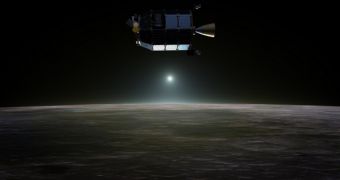Officials with the American space agency say that their new orbiter around the Moon is now ready to start conducting scientific studies of the lunar atmosphere and exosphere. The mission, called the Lunar Atmosphere and Dust Environment Explorer (LADEE), is led by the NASA Ames Research Center.
The spacecraft was built to analyze the lunar exosphere in unprecedented detail, and to study lunar dust in a manner not possible before. Additionally, it will investigate a mysterious glow of radiations that was detected by previous missions in the lunar atmosphere, especially during sunrise and sunset.
LADEE was launched into space aboard a Minotaur V delivery system, from the Mid-Atlantic Regional Spaceport at the NASA Wallops Flight Facility, in Virginia. Takeoff occurred on September 7, 2013, at 03:27 UTC. The spacecraft achieved orbital insertion around the Moon on November 20.
The 383-kilogram (844-pound) satellite is scheduled to conduct scientific investigations for 3 months. In terms of payloads, it carries a Neutral Mass Spectrometer (NMS) similar to an instrument on the Mars Science Laboratory (MSL) rover Curiosity, and an UV-Vis Spectrometer (UVS) for exosphere and dust studies, like the one on the NASA Lunar Crater Observation and Sensing Satellite mission.
Other instruments include the Lunar Dust EXperiment (LDEX), which will measure the properties of lunar dust directly, and a technology demonstrator for a new optical communication system, called the Lunar Laser Communication Demonstration (LLCD).
At this point, the spacecraft occupies a 2-hour, 8-by-37-mile (12-by-60-kilometer) orbit around the moon, which gives it an excellent vantage point for the type of studies it is meant to conduct.
“A thorough understanding of the characteristics of our lunar neighbor will help researchers understand other small bodies in the solar system, such as asteroids, Mercury, and the moons of outer planets,” explains LADEE program scientist Sarah Noble.
“Due to the lumpiness of the moon's gravitational field, LADEE's orbit requires significant maintenance activity with maneuvers taking place as often as every three to five days, or as infrequently as once every two weeks,” says ARC project manager Butler Hine.
“LADEE will perform regular orbital maintenance maneuvers to keep the spacecraft’s altitude within a safe range above the surface that maximizes the science return,” he concludes.

 14 DAY TRIAL //
14 DAY TRIAL //